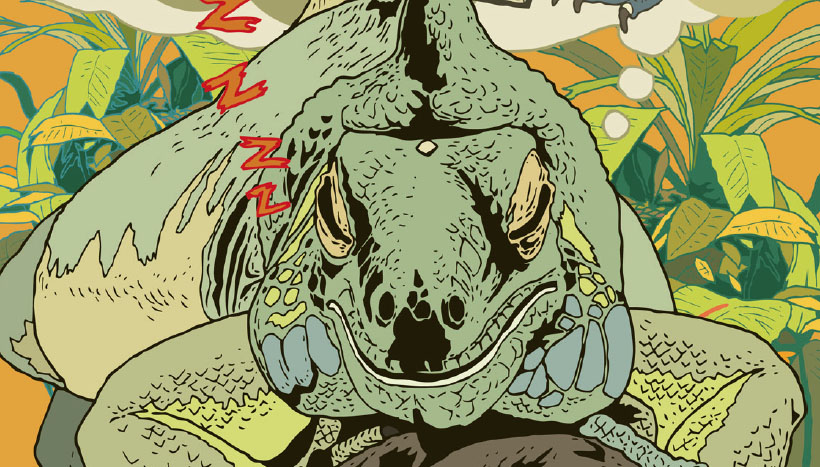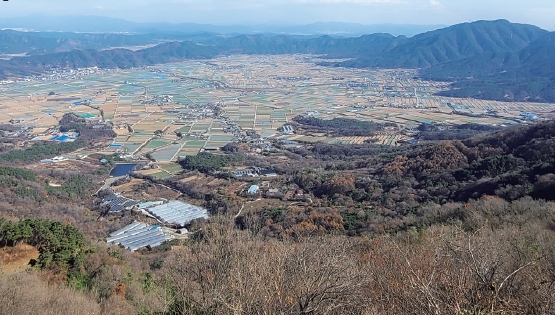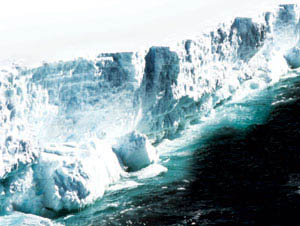20년 전 이번주, 즉 1969년 7월 20일 인류는 최초로 지구 이외의 세계에 발을 디뎠다. '닐 암스트롱'은 달의 표면에 내리면서 "이것은 한 인간에게는 작은 발걸음이지만 인류에게는 큰 도약이다"라고 말했다.
그다음 몇년 동안에 다섯번 달에 갔고 그런 뒤에는 중단해버렸다. 지금까지 17년 동안 아무도 달을 방문하지 않았다. 이제 달착륙 20주년을 기념하면서 이런 의문이 떠오를 수 있다. "도대체 무엇 때문에?" "달착륙으로 얻은 게 있는가?" "정말 큰 도약이 있었는가?"
아무렴, 소득은 있었다. 달착륙은 달과 우리의 먼 과거에 대해 알 수 있는 귀중한 기회를 주었다.
지구와 달 그리고 전체 태양계는 실제 약 45억5천만년 전에 생겨났다. 우리는 암석의 구성을 연구함으로써 지구의 먼 과거를 알 수 있다. 자연히 암석이 더욱 오래되고 변하지 않은 채 오래 지표면에 존속했을수록 우리의 지식은 확대 될수 있다.
그러나 열쇠가 되는 단어는 '변하지 않는'이라는 말이다. 암석은 영원히 불변인 채로 존속치 않는다. 지각은 이동하며 암석은 부숴지고 다시 형성된다. 바람과 물의 작용은 암석이 실제로 녹지 않았을 때에도 변화를 초래하게 된다. 그리고 생명체들은 지표의 모습을 엄청나게 바꿔 놓는다.
그 결과 우리가 찾아낼 수 있는 최고(最古)의 암석은 30여년이 약간 넘는 것 뿐이며 또 그런 것도 많지는 않다. 지구의 역사를 그 이상 파고드는 데에는 어려움이 있으며 지구의 태초의 15억년은 알지 못하고 있는 것이다. 태초의 15억년은 따라서 완전한 공백이며 우리가 지구권(圈)에만 머물고 있는 한 공백인 채로 그대로 남게 될 것이다.
허나 달은 상대적으로 작은 천체. 달의 중력은 공기나 쉽게 증발하는 어떤 액체를 붙들어 두기에는 불충분하다. 따라서 달에는 공기나 물 그리고 생명체가 없다. 현재뿐만 아니라 과거에도 없었다. 그것은 거꾸로 달의 표면은 생명체의 활동이나 바람 또는 파도에 의해 영향받지 않았다는 것을 뜻한다. 나아가 몸체가 작으므로 달은 내열(內熱)을 덜 생성시켰다. 내열은 다른 영향이 없을 때라도 지각을 움직이고 변하게 하는 것이다. 달리 말하면 지구는 지질학적으로 '살아 있는'것이고 달은 사실상 '죽어 있는' 것이다.
이것은 달의 표면은 지구의 표면보다 변하지 않은 채 훨씬 오랜 세월 지속돼 왔음을 뜻한다. 우주인들이 가져온 월석은 지구표면에서 발견할 수 있는 가장 오래된 암석보다 10억년이나 오래된 것이다. 이것으로 우리는 지구가 알려주지 않고 있는 태초의 10억년의 공백을 메울 수 있다.
달은 지구역사의 초기에 지구가 화성만한 크기의 천체에 얻어 맞았을 때 만들어졌다. (현재의 통설) 이 충돌로 지구표면층의 거대한 덩어리가 주변으로 떨어져 나갔고 지구에 부딪친 천체는 지구와 용해되어버렸다.
우주로 떨어져나간 물질 덩어리는 수증기처럼 뜨거워졌으나 점차 냉각되면서 여러가지 크기의 물체로 변했다. 그리고 이들 물체들이 서서히 합해져서 달이 됐다는 것이다. 달은 지구의 외곽층 물질들로 구성됐으므로 거의 암석뿐이며 지구의 중심부에서 발견되는 것과 같은 밀도 높은 광물들은 아주 적게 갖고 있다. 이것이 달의 밀도가 지구보다 낮은 이유이다.
달이 딱딱한 지각을 가질만큼 충분히 냉각되는 데에는 수억년이 걸렸다. 그러나 40억년 전쯤에는 딱딱한 지각이 형성되었으며 우리가 가져온 최고의 월석은 그때부터 존속돼온 것이다.
지난 40억년 동안 달이 겪은 유일한 중대변화는 아직 달의 주변에서 서성대던 천체들을 끌어당겼을 때 일어났다. 이런 사건으로 달에는 표면을 덮고 있는 수많은 분화구와 '대양'이 있다. 우리가 가져온 월석을 통해 과거 폭파(충돌) 사건의 여러 단계를 연구할 수 있다. 초기에 물론 가장 격렬했는데 그것은 당시에 충돌할 물체들이 많이 있었기 때문이다.
점차 시간이 지날수록 우주공간은 천체들이 사라짐으로써 깨끗해졌고 달은 정돈상태로 되면서 보다 적은 변화를 겪게 되었다. 약 32억년 전부터는 달뿐 아니라 지구도 상대적으로 조용해졌다. 이는 달이 폭파되면 지구도 비슷한 경험을 하게 되었기 때문이다. 지구에는 폭파로 생긴 분화구들이 바람, 파도 그리고 생명체들에 의해 마모되었다. 그러나 달에서는 그대로 남게 되었다.
비교적 최근에 달에도 변화가 생기게 되었다. '코페르니쿠스' 분화구는 8억1천만년 전에 생긴 것이며 장관(壯觀)을 자랑하는 '타이초' 분화구는 단지 1억9백만년 전에 생긴 것이다. 약간의 작은 분화구들은 2백만년 전에 생겼다.
우리가 다시 달탐험을 재개하면 달을 관측소나 광산, 인류의 새로운 주거로 이용하는 것 이외 그 표면을 세심하게 연구함으로써 달의 역사의 모든 상세한 내용을 파악할 수 있을 것이다. 또 그럼으로써 초기의 지구에서 어떤 일들이 있었는지 연역해 낼 수 있을 것이다. 달에서 발견한 여러 단서들은 지구에서 어떻게 생명이 시작되었으며 인류가 어떻게 등장하게 되었는지에 대한 우리의 추리를 도와줄 것이다.
Twenty years ago this week, on July 20, 1969, human beings set foot, for the first time, on a world other than Earth itself. Neil Armstrong stepped down onto the moon's surface and said, "This is one small step for a man, one giant leap for mankind."
There were five more visits to the moon in the next few years, and then they stopped. No one has visited the moon now in 17 years. So as we celebrate the 20th anniversary of that first moon landing, we might ask: What was it all for? Did we get anything out of it? Was there really a giant leap?
Well, yes; the moon landings gave us a valuable chance to learn about its-and our-far past.
The Earth and the moon, and the whole solar system, in fact, came into being about 4.55 billion years ago. We can learn about the Earth's distant past by studying its rock formations. Naturally, the older the rock and the longer it has existed in Earth's crust unchanged, the further back our knowledge can be pushed.
However, the key word there is "unchanged." The Earth's crust shifts and reform. The force of moving air and water introduces changes even when the rocks aren't actually melted. And life itself changes the landscape enormously.
The result is that the oldest rocks we can find are a little more than 3 billion years old and there aren't many of those. We have difficulty extending our knowledge of Earth's history back that far, and as for the first 1.5 billion years of Earth's existence, forget it. It remains a complete blank, and as long as we are imprisoned on Earth itself, it will continue to remain a complete blank.
The moon, however, is a smaller body. Its gravitational pull is insufficient to hold an atmosphere or any liquid that evaporates easily. That means there is no air on the moon, and no water, and no life. Not only is there none now, but there never was any. That, in turn, means that the surface has not been interfered with by the action of life, of by wind, or by waves. What's more, being a smaller body, the moon has developed less internal heat, and it is internal heat that keeps the crust moving and changing even if nothing else does. In other words, whereas the Earth geologically "alive," the moon is virtually geologically "dead."
This means the surface of the moon can continue to exist unchanged for much longer than the surface of the Earth can, and the moon rocks that the astronauts brought back are a billion years older than the oldest rocks we can find on Earth's surface. We can fill in a billion years of early history that the Earth is silent about.
The moon was created (it is current thought) when, very early in Earth's history, the planet was clobbered by an objcet about the size of Mars. That knocked a huge quantity of Earth's surface layers into nearby space while the striking body fused with Earth.
The material that was knocked into space was heated to a vapor but it cooled into a mass of innumerable particles of various sizes and these gradually coalesced and formed the moon. Since the moon was formed from the outer layers of Earth, it is almost entirely rocky and includes very little dense iron like that found at the Earth's core. That is why the moon is less dense than Earth.
It took a few hundred million years for the moon to cool down sufficiently to have a solid crust, but about 4 billion years ago that solid crust was there, and the oldest rocks that have been brought back date from that period.
In the last 4 billion years, the only significant changes undergone by the moon happened when it gathered in the remaining objects that still existed in its vicinity. These formed the numerous craters and the vast "seas" that now cover its surface. From the rocks we have brought back, we can study the different stages of that bombardment. The early history was the most active, of course, since there were still many objects with which to collide.
As time went on, space was cleared of most of the objects and the moon settled down and underwent fewer and fewer other changes. From about 3.2 billion years ago onward, things were relatively quiet-for Earth as well as the moon, for if the moon was bombarded, so was the Earth. It's just that on Earth the craters produced by that bombardment have worn away, thanks to winds, waves and life, whereas on the moon they remain.
Yet there have been changes on the moon comparatively recently, too. The crater of Copernicus was formed 810 million years ago, and the spcetacular crater of Tycho was formed only 109 million years ago. Some small craters were formed as recently as 2 million years ago.
If we were to go back to the moon, then, quite apart from its uses as an observatory, a mining station, an a new home for human beings, a careful and painstaking study of its surface could fill in all the details of its history and from that we could deduce what took place on the early Earth, too. The clues we find there might help us figure out how life began on this planet and how we all came to be.
(c) 1989, Los Angeles Times Syndicate
이 기사의 내용이 궁금하신가요?
기사 전문을 보시려면500(500원)이 필요합니다.
1989년 10월 과학동아 정보
🎓️ 진로 추천
- 천문학
- 지구과학
- 물리학

















